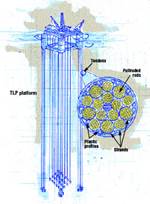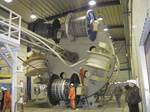Looking Forward
Current composite tether designs are leveraged to take advantage of existing oil-field manufacturing facilities. The wirerope stranding facilities, umbilical closing machines, steel anchors and installation methods used today for steel and synthetic cables can immediately accommodate rope-style composite tethe
Current composite tether designs are leveraged to take advantage of existing oil-field manufacturing facilities. The wirerope stranding facilities, umbilical closing machines, steel anchors and installation methods used today for steel and synthetic cables can immediately accommodate rope-style composite tethers. However, future designs could be more flexible. Rods could be pultruded in any shape. Salama of Conoco adds, “We are looking at materials with a specific gravity lower than water to reduce the pretension.” For example, PVC profiles with a specific gravity of 1.4 could be replaced with polyethylene profiles that have a 0.9 specific gravity (10 percent lighter than water). Other lightweight options include polypropylene, polystyrene and acrylonitrile butadiene styrene (ABS). Alternatively, a tether could be manufactured from a single strand, which would greatly simplify the entire system. The Doris Engineering/Freyssinet partnership envisions an extension of composite cable technology to moorings for other floating deepwater structures, such as catenary cables for spars, semi-submersibles and production ships.
Related Content
-
Composite resins price change report
CW’s running summary of resin price change announcements from major material suppliers that serve the composites manufacturing industry.
-
From the CW Archives: Airbus A400M cargo door
The inaugural CW From the Archives revisits Sara Black’s 2007 story on out-of-autoclave infusion used to fabricate the massive composite upper cargo door for the Airbus A400M military airlifter.
-
GKN Aerospace, Joby Aviation sign aerostructures agreement
GKN Aerospace will manufacture thermoplastic composite flight control surfaces for Joby’s all-electric, four-passenger, composites-intensive ride-sharing aircraft.











